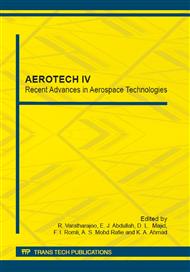[1]
Goldstien, R. J, 1971, Film Cooling, Advance Heat Transfer, Vol. 7, p.321– 329.
Google Scholar
[2]
Han, J. C., Dutta, S., and Ekkad, S, 2000, Gas Turbine Heat Transfer and Cooling Technology, Taylor and Francis, New York.
Google Scholar
[3]
Bunker, R. S., 2009, Film Cooling: Breaking the Limits of Diffusion Shaped Holes, Proceeding of International Symposium on Heat Transfer in Gas Turbine System, Antalya, Turkey.
DOI: 10.1615/ichmt.2009.heattransfgasturbsyst.160
Google Scholar
[4]
Ligrani, P. M., Wingle, J. M., Ceriello, S., and Jakson, S.W., 1994, Film Cooling from Holes with Compound Angle Orientations Part 1: Results Downstream of Two Staggered Rows of Holes with 3d Spanwise Spacing, ASME Journal of Heat Transfer, Vol. 116, p.341–352.
DOI: 10.1115/1.2911406
Google Scholar
[5]
Ligrani, P.M., Wingle, J.M., Ceriello, S., and Jakson, S.W., 1994, Film Cooling from Holes with Compound Angle Orientations Part 1: Results Downstream of Two Staggered Rows of Holes with 3d Spanwise Spacing, ASME Journal of Heat Transfer, Vol. 116, p.341–352.
DOI: 10.1115/1.2911406
Google Scholar
[6]
Gustafsson, K. M. B, and Johansson, 2001, An Experimental Study of Temperature Distribution on Effusion-Cooled Blade, ASME Journal of Engineering for Gas Turbines and Power, Vol. 123, pp.308-316.
DOI: 10.1115/1.1364496
Google Scholar
[7]
Kamil, A., Funazaki, K., Onodera, H., and Ideta, T., 2012, Experimental Investigations on Aero-Thermal Interaction of Film Cooling Airs Ejected from Multiple Holes: Shallow Hole Angle, Proceeding of ASME Turbo Expo 2012, Copenhagen, Denmark, pp. GT2012-68215.
DOI: 10.1115/gt2012-68215
Google Scholar
[8]
Kamil, A., Onodera, H., and Funazaki, K., 2012, Experimental and Numerical Investigation On Flowfield of Film Cooling from Multiple Holes, Proceeding of International Conference on Mechanical and Electrical Technology 2012, Kuala Lumpur, Malaysia.
DOI: 10.4028/www.scientific.net/amm.229-231.2094
Google Scholar
[9]
Ekkad, S. V., Shicuan Ou, and Rivir, B. R., 2004, A Transient Infrared Thermography Method for Simultaneous Film Cooling Effectiveness and Heat Transfer Coefficient Measurements From a Single Test, ASME Journal of Turbomachinery, Vol. 126, pp.597-603.
DOI: 10.1115/1.1791283
Google Scholar
[10]
Tropea, C., Yarin, A., Foss, J., 2007, Measurement of Surface Heat Transfer Characteristics Using Infrared Imaging, Springer Handbook for Experimental Fluid Mechanics, Springer-Verlag Publisher, pp.500-515.
DOI: 10.1007/978-3-540-30299-5
Google Scholar
[11]
S. R. Sargent, C. R. Hedlund, and P. M. Ligrani, 1998, An Infrared Thermography Imaging System for Convective Heat Transfer Measurements in Complex Flow, Measurement Science and Technology, Vol. 9, pp.1974-1981.
DOI: 10.1088/0957-0233/9/12/008
Google Scholar
[12]
Rebekah A. R., Alfred, D., and Wright, L. M., 2009, Measurement of Details Heat Transfer Coefficient and Film Cooling Effectiveness Distribution using PSP and TSP, Proceeding of ASME Turbo Expo 2009, Orlando, USA, pp. GT2009–59975.
DOI: 10.1115/gt2009-59975
Google Scholar


